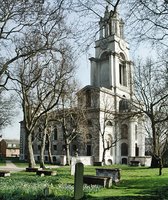Organ fanboys drool
I haven't posted much lately: too busy at work, unfortunately. I hope Talk Talk get their act together soon, because broadband at home has been ordered, it's just taking its time...
I attended an organ recital at St Anne’s church in Limehouse on Saturday. Since I don’t care for football, it didn’t matter that the concert was at 2.30 pm, when most of east London was watching England’s match against Paraguay. The church is a beautiful Hawksmoor-designed creation originally built in the eighteenth century. It’s fallen a little on hard times, as have many of these churches in East London, but attempts are underway at present to restore its superb interior.
Like many eighteenth century churches, St Anne’s is roughly rectangular in shape, with an upper balcony around three sides. The organ is at the west end. There’s no altar, and no crucifix, but a beautiful and surprisingly realistic stained glass window showing the crucifixion at the east end takes its place. The plasterwork on the ceiling is fabulous – a riot of shape and form that appears to be in good condition, mostly. However, it’s clear from just a cursory glance that the church still needs more work, with paint peeling off walls, and plaster cracking.

The restoration of the organ, built in 1851, had recently been completed, and the recital was to celebrate its completion. It’s a three manual Gray and Davidson, completed for the Great Exhibition, restored by William Drake. I don’t know a lot about organs, beyond liking the music. I can’t talk discursively about stops and pedals and open diapasons (I leave that to more knowledgeable types). The restored organ looks very good, with not too much gilding and carving: in fact, the case looks very much as it might have done in 1851.
The inaugural recital was played by Thomas Trotter, organist to the City of Birmingham, and a noted player (I have a recording of his of the complete works of Jehan Alain, which is very good). It was a varied programme, designed to show off the strengths of the organ (as well as the organist’s technique) ranging from the superb to the downright vulgar. Works included a transcription of an organ concerto by Handel, four short 16th century pieces, a Mozart Fantasia (the two organ Fantasias he wrote are very difficult to play, as Mozart wrote them for a mechanical organ!), a sonata by Mendelssohn, Andante by Smart and the first movement from Widor’s famous Organ Symphony No. 5. All were beautifully played, fully realising the potential and range of the instrument, and were warmly received by the audience. Trotter was an engaging presence, too, speaking from the balcony above the audience about the various pieces and why he’d chosen to play them at St Anne’s.
An afternoon very well spent, I thought. Just the thing on a hot summer’s day.
Labels: reviews

0 Comments:
Post a Comment
<< Home